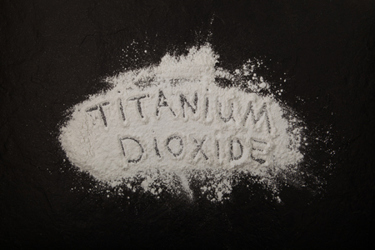The EU's Ban On TiO2 In Food May Impact Pharma. Here's What You Should Know.

The EU regularly evaluates the safety of all food and consumer products, including titanium dioxide (TiO2) used as a food additive and pharmaceutical excipient. Food-grade TiO2, which is commonly used as a whitening and brightening agent in various food products like chewing gum, mayonnaise, candies, and chocolates, is identified and labeled as E171. It is also identified as INS171 in the International Numbering System for Food Additives.
In March 2020, the Commission requested an updated opinion from the European Food Safety Authority (EFSA) on titanium dioxide's safety. Although EFSA's 2016 opinion found no immediate safety concerns, it noted data gaps, especially regarding particle size, which can affect its toxicological properties. The new EFSA opinion from May 2021 doesn't definitively label E171 as harmful but doesn't dismiss health risks like genotoxicity. Since the safety cannot be confirmed, the European Commission (EC) banned titanium dioxide (E171) as a food additive in the EU, starting with a six-month phasing out period from Feb. 7, 2022, to Aug. 7, 2022, after which a full ban applied. Following the ban in food application, the EC published the following (clause 17 and 18) in its Regulation (EC) No. 1333/2008:1
It is of critical importance that the pharmaceutical industry makes any possible efforts to accelerate the research and development of alternatives that would be used as a replacement for titanium dioxide (E 171) in medicinal products, and to submit the necessary variation to the terms of the marketing authorisations concerned. In the absence of such efforts, competent authorities may request the concerned stakeholders to submit objective and verifiable reason explaining the non-feasibility of the replacement.
The Commission is committed to review the necessity to maintain titanium dioxide (E 171) or otherwise delete it from the Union list of food additives for exclusive use as a colour in medicinal products within three years after the date of entering into force of this Regulation. This review should be based on an updated assessment of the EMA to be performed before 1 April 2024. It should take into account the progress made during this period to develop alternatives to titanium dioxide (E 171) in medicinal products both for new products and for replacing it in authorised products, and possible impacts on quality, safety and efficacy, as well as on the availability of medicinal products. Where replacement of titanium dioxide (E 171) in medicinal products has not taken place or been initiated within this period, only objective verifiable reasons related to the lack of feasibility of its replacement should be taken into account.
Given the EU’s scrutiny on TiO2, this article summarizes the technical purpose of TiO2, the impact of any potential ban in EU, and opinions expressed by regulators across the globe. This article will also highlight the Nov. 24, 2023, opinion from the World Health Organization (WHO) and the Food and Agriculture Organization (FAO) Joint Expert Committee on Food Additives (JECFA).2
Titanium Dioxide Applications In Pharma
In pharmaceuticals, TiO2 is commonly employed as an excipient in oral solid dosage forms like tablets, capsules, and granules for oral solutions, as well as in semi-solid forms for veterinary medications. It is estimated that at least 50,000 formulations contain titanium dioxide, making this excipient vital for pharma.
TiO2 has functionalities that need to be defined on a case-by-case basis. However, the following are the general uses of TiO2 as an excipient.
Coloring Agent: Like its use in the food industry, TiO2 is used as a coloring agent in pharmaceuticals. It can provide a white or opaque color to tablets, capsules, creams, ointments, and suspensions.
UV Protection: Titanium dioxide nanoparticles are sometimes used in sunscreens and topical medications for their ability to provide UV protection. They act as physical blockers, reflecting and scattering UV rays to protect the skin.
Coating Agent: TiO2 is used as a coating agent for tablets and capsules to enhance their appearance, protect them from moisture, improve swallowability, and control the release of the active ingredients.
Enhancing Drug Stability: In certain formulations, titanium dioxide can contribute to the stability of drugs by protecting them from degradation caused by light, moisture, or chemical reactions.
Impact Of A (Potential) Ban In Pharmaceutical Applications
An alternative for TiO2 should meet the following criteria:
- possess similar pharmaceutical properties such as opacification, stability, and degradation protection,
- be a chemically inert substance with comparable physicochemical properties,
- be compatible with other components of pharmaceutical products, and
- have an acceptable safety profile.
But currently there is no single alternative for TiO2 that is a drop-in replacement.
Possible alternatives identified include calcium carbonate, talc, and starch, but they have drawbacks like difficulties in obtaining thin films and elemental impurity risks.
Excipient manufacturers are working on TiO2-free formulations for tablet coatings and capsule shells, although these alternatives are not widely used yet, and information on their suitability is limited.
Replacing TiO2 with other pigments like iron oxides may lead to color differences and formulation adjustments, potentially affecting patient acceptability and compliance.
From a technical standpoint, finding alternatives to TiO2-containing coatings is feasible but challenging. Each medicinal product would require individual assessment and reformulation, which could lead to medicine shortages or discontinuations, especially for niche products or those with limited market share.
The potential removal of TiO2 could impact medicine quality, safety, and efficacy due to reformulation challenges, potential bioequivalence issues, and the need for alternative colorants to comply with regulations.
Indirect impacts include one-by-one reformulation, supply chain disruptions, and potential shortages caused by prioritization or manufacturing challenges.
While it is extremely important to address any safety concerns of an excipient, banning the material that is used in several thousands of formulations would impact patients’ health. However, this issue should create a sense of urgency to find new solutions that have no concerns, however remote, about safety.
Opinions From Other Regulators Across The Globe
Several international regulatory bodies, including the United Kingdom’s Food Standards Agency (FSA), Health Canada, Food Standards Australia New Zealand (FSANZ), and the U.S. FDA, have different opinions than the EFSA when it comes to TiO2 safety.
U.S. FDA3
FDA notes that some of the genotoxicity tests considered in the EFSA assessment included test materials not representative of the color additive, and some tests included administration routes not relevant to human dietary exposure. FDA did not identify concerns related to potential genotoxicity based on the data available and noted that TiO2 did not cause cancer in National Toxicology Program (NTP) carcinogenicity studies.
U.K. FSA4
On balance, the Committee on Toxicity of Chemicals in Food, consumer Products and the Environment (COT) considered that the weight of evidence did not support the conclusions drawn by EFSA. The Committee also agreed with the comments of the Committee on Mutagenicity of Chemicals in Food, consumer Products and the Environment (COM) with regard to risk communication that “As it stands the conclusion is highly risk adverse based on the weak evidence available, and it might create unnecessary concern to the public.” They considered that care should be taken when expressing the conclusions as they might cause unnecessary concern and they were uncomfortable with EFSA’s binary communication on a data set with a lot of uncertainties.
Health Canada5
Overall, the Food Directorate's comprehensive review of the available science of TiO2 as a food additive showed no evidence of cancer or other adverse effects in mice and rats exposed to high concentrations of food-grade TiO2 (long-term or lifetime study), no changes to DNA in various animal studies, and no adverse effects on reproduction, development, immune, gastrointestinal or nervous systems, or general health when rats were exposed from preconception to adulthood.
In summary, the Food Directorate's position is that there is no conclusive scientific evidence that the food additive TiO2 is a concern for human health. This is based on a review of the available scientific data relevant to food uses of TiO2. However, the directorate will continue to monitor the emerging science on the safety of TiO2 as a food additive and may revisit its position if new scientific information becomes available.
New Zealand’s FSANZ6
FSANZ has completed a review of the safety of titanium dioxide (TiO2) as a food additive. The review found there is currently no evidence to suggest dietary exposure to food-grade titanium dioxide is a concern for human health.
Other regulatory bodies such as India’s Central Drugs Standard Control Organisation (CDSCO), China’s National Medical Products Administration (NMPA), and Japan’s Pharmaceuticals and Medical Devices Agency (PMDA) have not commented much on the subject.
Summary Of JECFA’s Risk Assessment Of Titanium Dioxide
The Joint Expert Committee on Food Additives (JECFA),2 in collaboration with the WHO and the Food and Agriculture Organization (FAO), conducted an assessment on the health effects of TiO2 as a food additive. The key findings of the JECFA assessment are as follows:
- Low Oral Absorption: TiO2 (INS171) has low oral absorption from the gastrointestinal tract, resulting in very low bioavailability in humans.
- No Identified Hazards: JECFA found no evidence of carcinogenic, reproductive, or developmental toxicity effects in animals after long-term exposure to TiO2.
- Limited Genotoxicity Evidence: The available evidence on genotoxicity has limitations, mainly due to challenges in applying standard testing methodologies to nanoparticles like TiO2.
- Need for Further Research: Dr. Moez Sanaa from WHO emphasized the necessity for more research on TiO2nanoparticles' distribution in food and the development of appropriate genotoxicity tests.
- Reaffirmed ADI: Despite limitations, JECFA reaffirmed the acceptable daily intake (ADI) of "not specified" established since 1969, considering the very low oral absorption and lack of identified hazards associated with TiO2in the diet.
Conclusion
Regulatory agencies such as EFSA have a critical role to play in human health. Perceived safety concerns about TiO2 highlighted by EFSA should be given careful consideration, and further research needs to be done to reach conclusions on the safety of TiO2. However, banning TiO2’s use in pharma without an alternative identified would also put patients’ health at risk. On one hand, the pharma industry is justified in arguing against a ban until a replacement is found, but on the other hand the pharma industry should increase the sense of urgency to find an alternative material to potentially replace TiO2. Concerns expressed by EFSA should be used to disrupt the status quo and look for alternatives for TiO2.
References
- https://eur-lex.europa.eu/legal-content/EN/TXT/?uri=uriserv%3AOJ.L_.2022.011.01.0001.01.ENG
- https://cdn.who.int/media/docs/default-source/food-safety/jecfa/summary-and-conclusions/jecfa-riskassemsent-of-titanium-dioxide-released.pdf?sfvrsn=d43ddb0e_3&download=true
- https://www.fda.gov/industry/color-additives/titanium-dioxide-color-additive-foods
- https://cot.food.gov.uk/Intro%20Review%20of%20EFSA%20Opinion%20on%20the%20
Reproductive%20Toxicity%20of%20Titanium%20Dioxide%20as%20a%20Food%20Additive - https://www.canada.ca/en/health-canada/services/food-nutrition/reports-publications/titanium-dioxide-food-additive-science-report.html
- https://www.foodstandards.gov.au/consumer/foodtech/Review-of-titanium-dioxide-as-a-food-additive
About The Author:

Rajendran (Raj) Arunagiri has been in the pharma industry for a decade and has successfully developed and launched a new excipient. He is a co-author of technical articles and is an invited speaker at conferences focused on excipients and drug delivery. He specializes in the area of poorly soluble APIs and modified release. Arunagiri welcomes you to reach out to him for questions, comments, and collaboration ideas at raj.gceb@gmail.com.
